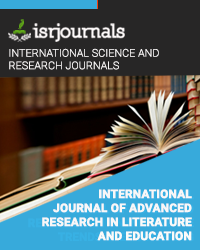pedagogical approach in designing materials using computer assisted language learning
C. Chamundeshwari,,R. Ganesan,
Published in International Journal of Advanced Research in Literature and Education
ISSN: 2348-2346 Impact Factor:1.9 Volume:1 Issue:1 Year: 08 December,2013 Pages:1-7

Abstract
Teachers need to provide the learning resources to the students to enhance their knowledge and to show their performance depending on the quality of the learning content in the classroom. In this electronic era, teaching modules are designed by the teachers on their own for motivating students’ interactive learning. The innovative ways of designing materials pave the way for teacher development to a remarkable extent. The authors would explicate in this article on the language training materials designed by the target language teachers of her Institution, with the integration of ‘web resources’, their impact on students’ language performance’ reflections on designing materials.
Kewords
Interactive learning; Computer Assisted Language Learning (CALL); modules; internet resources; business English
Reference
1. Anderson (2012). The application of open educational resources to EAP curriculum. Retrieved from The Connexious Project. P (1- 10). http://cnx.org/content/m43623/1.1/ 2. Andy B. Lane (2008). Open Learn: Sharing and shaping open educational resource. Retrieved from http://universitydesign.asu.edu/db/openlear n-sharing-and-shaping-open-educational- resource 3. Bruner, J.(1996). Constructivist Theory. Retrieved from http://www.instructionaldesign.org/theories/cons tructivist.html 4. Dhaif H., (2004). ―Computer Assisted Language Learning: A Client's View, Computer Journal Assisted Language Instruction Consortium, vol.7, no. 2, pp. 467-469. 5. Howard . J. Guidelines for Designing Effective Language Teaching Materials. Retrieved from http://www.paaljapan.org/resources/proceedings/ PAAL9/pdf/Howard.pdf 6. Kristinsdóttir, S.B. (2001). Constructivist Theories. Retrieved from http://mennta.hi.is/starfsfolk/solrunb/constr uc.htm 7. Lai Lai Kwan, (1999). A Tutor-Guided Learning Scheme in a Self-Access Centre. Retrieved from http://iteslj.org/Techniques/Lai-Tutor- Guided.html The Internet TESL Journal. Vol, No. 9. 8. Nelson. E, Ward. M, and Kaplow.R. (1976). Two New Strategies for Computer Assisted Language Instuction, Computer Journal of Foreign Annals, vol. 9, no.2 pp. 28-37. 9. Nunan, D. (1987). The teacher as a curriculum developer: An investigation of curriculum processes within the Adult Migrant Education Program. South Australia: National Curriculum Resource Centre, p. 75. 10. Nunan, D. (1988). Principles for designing language teaching materials. Guidelines, Okada, 10(2), 1–24. 11. Podromou, L. (2002). The great ELT textbook debate. MET, 11 (4), 25–33. 12. Richard Jack C and Charles Lockhart, (1990). Reflective Teaching in Second Language Classrooms, Cambridge University Press. p. 6. 13. Son, J.-B. (2007). Learner experiences in web- based language learning. Computer Assisted Language Learning. 20(1), 21-36. 14. Thakrar, J., Zinn, D. & Wolfenden, F. (2009). Harnessing Open Educational Resources to the Challenges of Teacher Education in Sub- Saharan Africa. Retrieved from http://www.irrodl.org/index.php/irrodl/arti cle/view/705/1319 (n.d). 15. Vicki Trowler (2010). Student engagement literature review. Retrieved from

